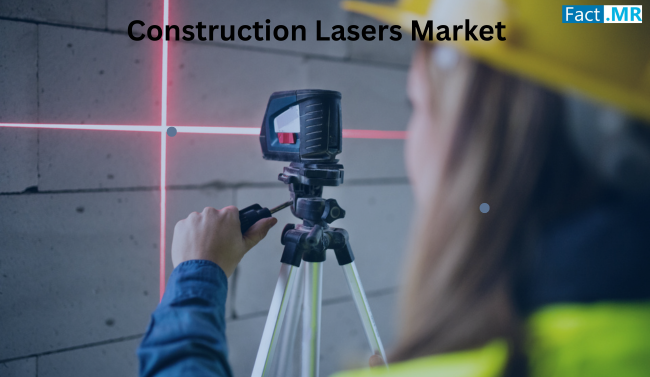Precision and efficiency are the cornerstones of modern construction. With increasing emphasis on productivity, safety, and structural accuracy, the construction lasers market is gaining significant traction. Construction lasers are indispensable tools that assist in leveling, aligning, and plumbing across a variety of infrastructure projects. As digital transformation reshapes the construction industry, laser-guided systems are evolving to offer enhanced reliability and user-friendliness.
The adoption of advanced laser technologies reflects the sector’s shift towards automation, data integration, and site accuracy. From large-scale civil infrastructure to residential projects, construction lasers are emerging as vital components for project success.
Market Overview:
The construction lasers market includes a broad array of devices designed to streamline onsite measurement and layout tasks. These tools enable contractors, engineers, and surveyors to achieve high levels of accuracy, reducing rework and saving time. Laser types range from spot/plumb/dot lasers, line-level lasers, rotary-level lasers, to combination lasers, each suited for different project needs.
The evolution of construction lasers is closely tied to increasing urbanization, infrastructure modernization, and demand for smart construction tools. Technological advancements such as automatic leveling, digital displays, and remote operation are transforming traditional job sites into high-precision workspaces.
Regional Insights:
North America:
The North American region remains a key player in the construction lasers market due to the early adoption of digital construction tools and ongoing infrastructure upgrades. High labor costs and the push for operational efficiency are encouraging contractors to integrate laser-based alignment tools for better output and safety compliance.
Europe:
Europe follows closely, with strong demand stemming from stringent building codes and a robust focus on green and sustainable construction. Regulatory frameworks encouraging precision in building measurement and inspection are accelerating the adoption of laser-guided systems across residential and commercial sectors.
Asia-Pacific:
Asia-Pacific is witnessing rapid growth in this space, driven by extensive urban expansion, smart city development, and increasing investment in transport and industrial infrastructure. Countries like China, India, and Southeast Asian nations are focusing on cost-effective and time-saving construction technologies, making laser tools a preferred choice.
Key Trends & Forecast:
Automation and Smart Technology Integration
Modern construction lasers are increasingly being integrated with digital technologies such as GPS, BIM (Building Information Modeling), and IoT. These integrations help in seamless data collection, remote operations, and real-time error correction. The trend is driving adoption across both large-scale projects and small construction firms.
Rise in Self-Levelling and Automatic-Leveling Lasers
Manual leveling tools are gradually being replaced with self-leveling and automatic-leveling lasers, which provide faster setup and reduced human error. These advanced systems enhance accuracy in grading, pipe laying, foundation work, and ceiling installations.
Increased Demand in Renovation and Retrofitting
As older infrastructure in urban areas demands renovation, the need for non-invasive, precision-based measurement tools is growing. Construction lasers are enabling efficient space assessment, wall alignment, and structural repairs without extensive demolition.
Focus on Sustainability and Waste Reduction
Laser tools contribute to sustainability by reducing material waste, minimizing errors, and improving overall site management. Their accuracy in measurements ensures reduced need for rework, translating into lower emissions and resource consumption during construction.
Hybrid and Multi-functional Laser Tools
The market is seeing an influx of hybrid laser systems that combine multiple functionalities—such as line, dot, and rotary lasers—into a single unit. These versatile tools are ideal for multi-tasking and have become popular in commercial construction and interior installations.
Segmentation Analysis:
By Type of Laser:
- Spot/Plumb/Dot Lasers: Primarily used for point transfer and plumbing work, especially useful in framing and metal stud placement.
- Line Level Lasers: Widely adopted for indoor alignment tasks such as tiling, cabinetry, and drywall installation.
- Rotary Level Lasers: Preferred for outdoor and large-scale leveling operations including grading, foundation layout, and excavation.
- Combination Lasers: Versatile solutions that offer both line and point laser capabilities, ideal for contractors managing diverse projects.
By Operation:
- Manual-Leveling Lasers: Suitable for basic applications and small projects, though they require more time and skill to set up.
- Self-Leveling Lasers: Automatically adjust to level, reducing setup time and enhancing accuracy.
- Automatic-Leveling Lasers: Offer the highest degree of precision with internal motors that maintain perfect alignment over long distances and uneven terrain.
By Range:
- Laser tools are available in varying ranges, suitable for short indoor projects to long-range outdoor tasks. Choosing the right range ensures optimal visibility and performance under different lighting and environmental conditions.
By Application:
- Residential Construction: Used for interior layout, tiling, cabinetry, and finish work.
- Commercial Construction: Essential for HVAC installation, ceiling layout, and floor leveling.
- Infrastructure Projects: Extensively used in road construction, tunneling, bridge building, and railway alignment.
Competitive Landscape:
The construction lasers market is characterized by a mix of established players and emerging tech innovators. Key manufacturers are focused on research and development, expanding product portfolios, and offering training and support services to enhance product adoption.
Strategic partnerships with construction companies, rental service providers, and retail channels are playing a crucial role in expanding market reach. Additionally, some firms are investing in user-friendly interfaces and mobile connectivity features to attract a younger, tech-savvy workforce.
To maintain competitiveness, companies are:
- Developing robust, weather-resistant laser tools for challenging environments.
- Introducing ergonomic and lightweight designs for ease of use.
- Offering bundled packages that include tripods, detectors, and batteries for enhanced convenience.
Applications & End-Use Outlook:
Construction Companies:
Large construction firms are deploying laser systems for grading, layout, and structural alignment to improve efficiency and meet tight deadlines.
Surveyors and Civil Engineers:
Surveying professionals utilize rotary and long-range lasers for boundary marking, elevation checking, and site grading.
Renovation and Interior Design:
Home remodelers and interior designers benefit from line lasers for installing cabinetry, wallpaper, tiles, and lighting fixtures with absolute precision.
Equipment Rental Providers:
With the rising cost of construction equipment, rental services are seeing a surge in demand for laser tools, especially for short-term or specialized use cases.
Conclusion:
The construction lasers market is evolving as an essential pillar of modern construction practices. As the industry moves toward automation, safety, and sustainable development, the demand for precise, easy-to-use laser systems will only grow.
From self-leveling rotary lasers on infrastructure sites to compact line lasers for home interiors, these tools are streamlining operations and enabling accurate project execution. Stakeholders across the value chain—manufacturers, contractors, surveyors, and designers—must align with this technological momentum to maintain efficiency, precision, and competitiveness in the construction domain.
Accessing in-depth market insights and trends will empower decision-makers to adopt the right laser solutions and future-proof their operations in an increasingly digital and accuracy-driven world.



